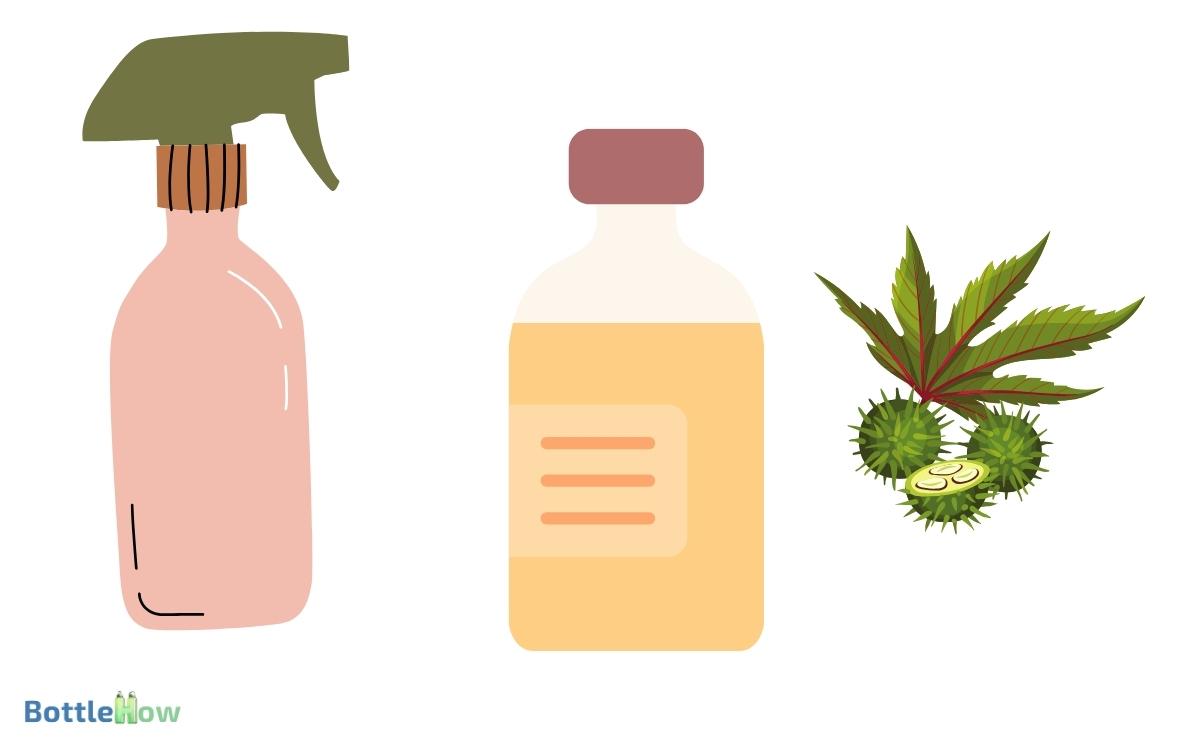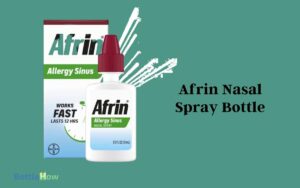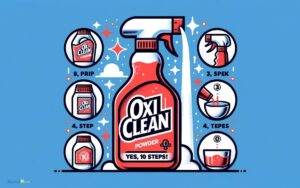Can You Put Castor Oil in a Spray Bottle? Yes!
Yes, you can put castor oil in a spray bottle. To guarantee effective spraying, you’ll need to select a suitable spray bottle, preferably made from PET or HDPE, which resists oil degradation.
Since castor oil has a high viscosity, opt for a bottle with an adjustable nozzle to manage spray patterns and output effectively.
Always warm the oil slightly to reduce its viscosity, which aids in smoother application and prevents clogging.
Before use, vigorously shake the bottle to maintain an even consistency throughout the solution. With these careful preparations, you’ll enhance the performance and benefits of castor oil in spray form, revealing further utility and advantages.

Key Takeaways
Understanding Castor Oil Properties
Before you begin using castor oil, it’s essential to understand its unique chemical composition and physical properties.
Castor oil, derived from the seeds of the Ricinus communis plant, mainly consists of ricinoleic acid, a type of fatty acid.
This component is notable for its high viscosity and density compared to other carrier oils, which impacts how it interacts with various materials, including spray mechanisms.
It’s also hygroscopic, meaning it absorbs moisture from the air, which can influence its storage and handling requirements.
You’ll find its solubility in alcohol useful, though it’s only slightly soluble in water. Understanding these properties helps you effectively utilize castor oil in serving others, ensuring ideal application and stability in various uses.
Benefits of Spray Application
Applying castor oil through a spray mechanism offers precise, controlled distribution, enhancing its effectiveness in various applications.
This method allows for uniform coverage, important when you’re targeting specific areas such as scalp, skin, or even plants.
By spraying, you minimize waste and maximize the area covered, guaranteeing efficient use of the oil.
The atomization of castor oil into fine droplets increases the surface area, facilitating quicker absorption and more immediate effects.
Whether you’re addressing hair growth, skin hydration, or garden pests, the spray application ensures that your efforts are more directed and fruitful.
Additionally, it reduces the mess often associated with traditional methods of application, making your task cleaner and more manageable.
Choosing the Right Spray Bottle
When selecting a spray bottle for castor oil, it’s vital to choose one that can handle the oil’s viscosity and guarantee a fine, even mist.
You’ll need a bottle with components resistant to oil degradation. Opt for materials like PET or HDPE, which are durable and less reactive with oily substances.
The nozzle is important; look for one with adjustable settings to control spray output, ensuring you can switch between a fine mist and a more direct spray as needed.
The pump mechanism should be robust, capable of handling thicker liquids without clogging or breaking.
This choice won’t only extend the life of your spray bottle but also enhance the effectiveness of castor oil application, maximizing benefits for those you serve.
Preparing Castor Oil for Spraying
To prepare castor oil for spraying, you must first select a bottle that guarantees a fine, even mist. If you’re mixing the oil with other liquids, it’s essential to achieve a homogeneous solution to prevent clogging the spray mechanism.
Mastering the ideal spraying technique requires adjusting the nozzle for a consistent spray pattern and pressure.
Choose the Right Bottle
Selecting an appropriate spray bottle is crucial for the effective application of castor oil. You’ll need a bottle that can handle the viscosity of castor oil while ensuring a fine, even spray.
Here are key factors to keep in mind:
- Material Compatibility: Confirm the bottle is made of a material resistant to oil, such as PET or HDPE plastic, which provides durability against the thick, sticky nature of castor oil.
- Nozzle Functionality: Opt for a nozzle that offers a fine mist setting to prevent clogging and ensure uniform distribution.
- Size and Ergonomics: Choose a size that’s easy to handle and maneuver, especially if you’ll be using it frequently or for extended periods.
Picking the right spray bottle maximizes efficiency and effectiveness in application.
Mixing With Other Liquids
Consider diluting castor oil with compatible liquids to enhance its sprayability and effectiveness.
When selecting a diluent, consider liquids that maintain the integrity of castor oil while reducing its viscosity.
A common choice is isopropyl alcohol, which mixes well and evaporates quickly, leaving the beneficial properties of the oil on the applied surface.
Alternatively, you could use lighter oils such as fractionated coconut oil or jojoba oil, which are less viscous and can help in creating a finer mist.
It’s essential to use precise ratios, generally starting with a 10% dilution of castor oil to 90% of the chosen liquid.
This balance ensures that the mixture remains effective while being fluid enough to be sprayed efficiently.
Optimal Spraying Technique
Before spraying, make sure you shake the bottle vigorously to achieve a consistent mixture of castor oil and its diluent. This guarantees that you’re applying an evenly distributed formula. If the ingredients are not properly mixed, the effectiveness of the solution may be compromised. Using acetone in a spray bottle as an alternative solvent can enhance dispersion, but be sure to test it on a small area first. Proper mixing ensures optimal coverage and prevents uneven application.
Here are the next steps:
- Adjust the Nozzle: Select a fine mist setting on your spray bottle to maximize coverage while minimizing waste.
- Test the Spray: Always perform a small patch test on an inconspicuous area first to confirm the mixture doesn’t cause any adverse effects.
- Apply Evenly: Hold the bottle about 6 inches away from the target area and spray in a sweeping motion to coat the surface evenly without saturating it.
This technique will enable you to serve effectively, ensuring efficient and safe application of castor oil.
Step-by-Step Filling Guide
To start, gather a clean spray bottle, a funnel, and your castor oil to guarantee a smooth and precise filling process.
Make sure the spray bottle is thoroughly cleaned to prevent any contamination that could affect the oil’s properties.
Place the funnel securely at the bottle’s mouth to avoid spills. Carefully pour the castor oil through the funnel, monitoring the volume to prevent overfilling.
Aim to fill the bottle up to about three-quarters, allowing space for air, which aids in the spraying mechanism’s functionality.
After filling, securely fasten the spray nozzle to prevent any leakage. This method ensures that the oil is transferred cleanly and efficiently, optimizing your ability to serve others effectively through proper application.
Tips for Effective Usage
Now that your castor oil is securely in the spray bottle, let’s focus on maximizing its effectiveness through proper application techniques.
Employing a structured approach will ensure you deliver the utmost benefits of castor oil to those you serve.
Consider the following tactical methods:
- Maintain Consistent Pressure: Guarantee a steady spray pressure to distribute the oil evenly. This consistency is vital for uniform coverage and peak absorption.
- Adjust Spray Nozzle: Fine-tune the nozzle for a mist setting to prevent over-application and waste. A finer mist penetrates the targeted areas more effectively, enhancing the therapeutic properties.
- Apply at Optimal Times: For best results, apply during the cooler parts of the day or in well-ventilated areas to facilitate natural absorption. This timing leverages the oil’s properties when environmental conditions are most advantageous.
Potential Challenges and Solutions
You may encounter the issue of high viscosity with castor oil, which can hinder its ability to be sprayed effectively.
To prevent the spray nozzle from clogging, consider diluting the oil or selecting a nozzle designed for thicker liquids.
For achieving best dispersion, using a mechanical or battery-operated sprayer can guarantee a more uniform application.
Viscosity Issues Addressed
Addressing the high viscosity of castor oil is crucial when attempting to use it in a spray bottle. Its thick nature can impede the spray mechanism, preventing a smooth, even distribution.
To effectively manage this, consider these adjustments:
- Dilution: Mixing castor oil with a thinner carrier oil can greatly reduce its viscosity. This makes the oil easier to spray without compromising its benefits.
- Heating: Gently warming castor oil lowers its viscosity. However, make sure the temperature is controlled to avoid degrading the oil’s properties.
- Agitation: Regularly shaking the mixture within the spray bottle helps maintain an even consistency, aiding in a smoother spray function and preventing any settling or separation of oils.
Understanding and implementing these strategies will enhance your ability to use castor oil effectively in a spray application.
Spray Nozzle Clogging Prevention
To prevent the spray nozzle from clogging when using castor oil, selecting the appropriate nozzle size and regularly cleaning the mechanism are vital.
This guarantees the uninterrupted performance of the spray, essential for your needs in delivering consistent service.
Understanding the viscosity of castor oil is key to choosing the correct nozzle. A smaller nozzle might clog faster due to the thick nature of castor oil.
Here’s a quick guide to maintaining your spray bottle:
| Action | Benefit |
|---|---|
| Choose larger nozzle | Reduces clogging risk |
| Regular cleaning | Maintains peak spray function |
| Warm water rinse | Dissolves oil residues |
| Use dilutants | Lowers viscosity, eases flow |
| Inspect regularly | Early detection of potential issues |
Adhering to these practices will help you serve others more effectively, ensuring dependable tool performance.
Achieving Optimal Dispersion
Achieving the ideal dispersion of castor oil through a spray bottle presents several challenges, primarily due to its high viscosity.
To tackle these, consider the following technical solutions:
- Dilution: Dilute castor oil with a compatible carrier fluid to reduce its thickness. This guarantees a finer mist when sprayed, enhancing uniform application.
- Nozzle Selection: Opt for a spray nozzle that can handle thicker liquids. Nozzles with larger orifices or adjustable spray patterns are particularly effective.
- Agitation: Regularly agitate the solution within the spray bottle. This prevents the oil from settling at the bottom and promotes consistent dispersion throughout the application process.
These steps will help you serve others more effectively by making sure that the benefits of castor oil are evenly distributed.
Conclusion
As you harness the power of castor oil through spray application, remember the ancient adage, ‘A stitch in time saves nine.’
Selecting a robust spray bottle and properly diluting the oil guarantees a hassle-free usage.
By following these precise steps, you can optimize the benefits, tackle any challenges, and achieve desired outcomes efficiently.
Keep this guide handy, and you’ll find that deploying castor oil becomes as rhythmic and seamless as a well-conducted symphony.






